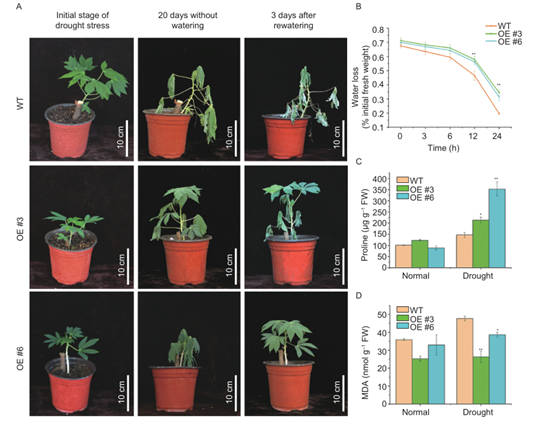The functional gene research team of the Institute of Tropical Bioscience and Biotechnology of the Chinese Academy of Tropical Agricultural Sciences has made new progress in the research of cassava's adaptation mechanism to drought stress. It has identified a new key long-chain non coding RNA (lncrna) that regulates cassava's adaptation to drought stress, determined the mechanism of this lncrna mediating cassava's response to drought stress, and provided new gene resources and theoretical support for cultivating new stress resistant cassava germplasm.

Determination of phenotype and physiological indexes of cassava lines overexpressing dir under drought stress
The stored root of Manihot esculenta is rich in starch, which is the main source of food for nearly 800 million people in the tropical and subtropical regions of the world. In China, cassava is mainly used for food, feed and industrial development. Lncrna is a kind of non coding RNA widely existing in the biological world. In higher plants, lncrna is an important stress resistance regulator, which can regulate plant gene expression, secondary metabolite synthesis and metabolism, and improve plant stress tolerance. However, there is no functional study on lncrna in cassava under drought stress.
The research team found that expressing drought-produced intergenic lncrna (DIR) in cassava plants can improve the drought tolerance of plants. In depth studies have found that dir can improve the drought tolerance of cassava by increasing the accumulation of osmotic protective substances (such as proline) and changing the expression of drought stress response genes. In addition, studies have also found that dir can recruit proteins related to messenger RNA (mRNA) extranuclear transport and protein quality control pathways, indicating that dir is closely related to mRNA transport and protein metabolism.
The relevant research results were published in the Journal of integrated agriculture, a journal of JCR zone I, under the title "a novel long non coding RNA, dir, increases drop tolerance in cassava by modifying stress related gene expression". Dong Shiman, who has graduated with a master's degree from our institute, is the first author of the paper, and Peng Ming, Liao Wenbin, Li Shuxia, associate researcher of the functional gene research team of the Institute of Tropical Bioscience and Biotechnology, and Yan Huabing, researcher of the Economic Crop Research Institute of the Guangxi Academy of Agricultural Sciences, are the co corresponding authors of the paper. Associate researcher Li Shuxia has been engaged in the research on the molecular mechanism of plant response to abiotic stress for a long time, and has successively excavated many important lncrnas related to low temperature and drought, providing important theoretical references for the next step of creating new stress resistant cassava germplasm. The research was supported by the national key R & D plan and the basic scientific research business fees of the central public welfare scientific research institutions.


